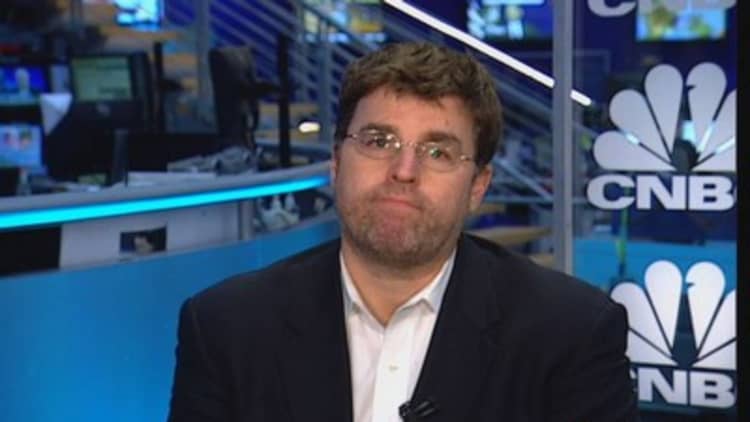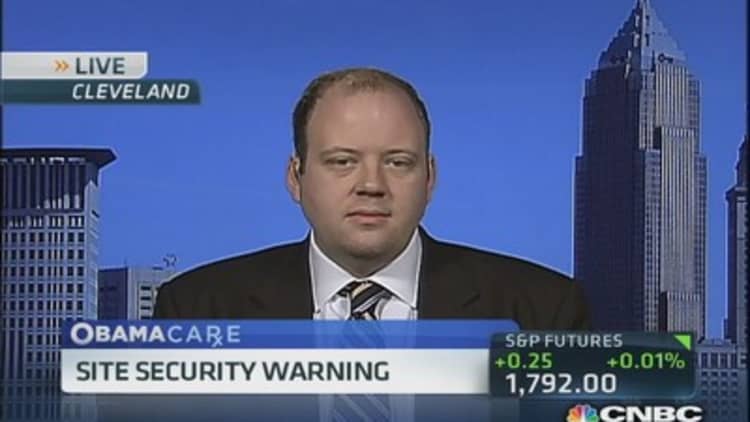
An estimated 10 percent of all enrollments now being made on the federal Obamacare marketplace contain data errors that could delay people from actually getting health coverage, officials disclosed Friday.
And that error rate for enrollments submitted via HealthCare.gov and then sent to insurers before December was an estimated 25 percent, officials revealed.
The rate fell in the past week, officials said, because of repair efforts to HealthCare.gov's, particular the discovery and fix of one particular software problem that was causing an estimated 80 percent of data errors, officials said.
But both past and present error rates are much higher than 1 percent, the rate which insurers considered to be unacceptable when doing business outside the Obamacare exchanges. And they are raising serious questions about whether significant numbers of people will actually be without insurance Jan. 1 despite believing they have enrolled.
A spokeswoman on Friday said the federal government and insurers now are engaged in a "very intensive process" to identify enrollment applications that contain the so-called "834 errors," and to get them fixed so that people will actually have coverage. The errors included forms not being generated, duplicate enrollment forms, and forms with missing or erroneous data.
"We are going to get to a very granular level to identify the individuals who have been impacted, so we have the ability to reach out to them directly," said the spokeswoman, Julie Bataille, of the federal Centers for Medicare and Medicaid Services, which operates HealthCare.gov.
Bataille, whose agency before Friday had repeatedly refused to release its internal estimates of 834 error rates, also said that federal workers and contractors were laboring to fix the problems that are continuing to cause some 834 errors in current enrollments.
She said people who have completed their enrollments online should make sure to make their initial premium payments to insurers — which could flag insurers that there might be a problem with that person's enrollment — or ask their insurer to confirm their enrollment is processed. To fix the errors, insurers are often having to re-enter data by hand for each individual.
Bataille said the estimates of the error rates are based on sampling of enrollments, and that the variation in the kinds of errors have "made it difficult for us" to precisely quantify the error rate.
"We do not have precise numbers," she said.
Still, in October and November the error rate "could have been as many as one in four," Bataille said.
With the recent fixes, "we believe nine out of 10 834 transactions are now being successfully transmitted," she said.
(Read more: "Fixed" Obamacare site still not secure: hacker)
HealthCare.gov sells Obamacare insurance to residents of 36 states, and has to date enrolled more than 150,000 people. However, the 15 other Obamacare exchanges being run by 14 other states and the District of Columbia are also experiencing problems from 834 errors.
After the botched, software-glitch-ridden Oct. 1 launch of HealthCare.gov, federal officials had initially denied there were any significant problems with 834 transmissions, despite CNBC.com reporting early on that insurers were seeing error rates as high as 50 percent.
But in late October, after being recruited by President Obama to oversee the repair effort on the site, management guru Jeff Zients said 834 errors were at the top of his list of problems to address.
Robert Zirkelbach, a spokesman for industry trade group America's Health Insurance Plans, said, "The new process put in place this week is making a difference. The enrollment files are getting better, but there is more work to do to ensure consumers are covered."

Cristine Vogel, an associate director in Navigant's health-care practice, said the disclosure about the 834 error rates are troubling, and further support her belief that the Obamacare insurance program is facing a possible "perfect storm" of low enrollment and bad data.
"While this is a measurable improvement, a 10% error rate is still a serious concern for the accuracy of the data, which has implications for insurers, providers and consumers, Vogel said.
"While we can now say that only 1 in 10 consumers is going to have a problem, that's still a lot of people," Vogel said. "As enrollment grows every day, this means we're adding more and more errors to the system. While we are decreasing the error rate, we're increasing the enrollment, which by design is increasing the number of people impacted."
Vogel and other experts told CNBC that the 834 problems and low enrollment could leave insurers facing possible losses from Obamacare policies, and hospitals and other providers facing increased costs.
"I try to be an optimist, it's just harder each day," said Vogel, who previously was special advisor for health-care reform to Connecticut's governor. She said she expects the cumulative effect will eventually hurt people providing and receiving care.
"We all knew that it was going to impact the insurance industry, and now it's going to impact the provider and the consumer," she said. "It's difficult for me not to think that perfect storm that we've all been trying to avoid, and not plan for, may be approaching."
Since open enrollment for Obamacare insurance began in October, an estimated 330,000 people nationally have applied for eligibility and selected an insurance plan being sold through the federally run HealthCare.gov site or the 15 other health exchanges.That is only about 25 percent of the 1.2 million people federal officials originally estimated would have signed up in the first two months of enrollment. People have until Dec. 23 to enroll in Obamacare coverage to have it kick in by Jan. 1.
(Read more: Fast track: Fed Obamacare site enrolls 29K in just two days)
In addition to the 834 error rate, another persistent technical problem on HealthCare.gov is preventing it from sending applications for the government-run Medicaid program to the states where the applicants live.
Both glitches could lead to unknown numbers of people not having insurance coverage on Jan. 1 as they assumed they would. And if those people get health-care treatment when they are not covered, they could default on charges they incur, Vogel and other experts told CNBC.com.
Paul Tiede, executive leader of solutions for SunGard's insurance business, said the low enrollment to date in Obamacare insurance is not, in itself, a threat to the bottom line of most insurers, because it would represent a small fraction of their current business. But Tiede warned "that could change."
"The great risk is the healthy 20- and 30-year-olds sit it out," and don't enroll, leaving insurers with a risk pool that is heavily overweighted with an older, sicker group of enrollees who use benefits, Tiede said, referring to a phenomenon known as adverse selection. "That would be serious."
Another expert, Nancy Thompson of CBIZ Benefits & Insurance Services, said "no one had the crystal ball" that predicted just how dire the enrollment levels and data problems in enrollment files would be at this point, more than two months after Obamacare launched.
"Let's face it, with the number of uninsured that we have in the United States, for us to be sitting [at less than 400,000 enrolled], that's staggeringly low," said Thompson, senior vice president and sales director at CBIZ.
"The bigger concern is, what kind of individuals are enrolling," Thompson said, echoing Tiede's concern about adverse selection. "The low enrollment numbers could absolutely play havoc on the rating structure."
Thompson noted that when they designed their plans and set premium prices for 2014 for the Obamacare exchanges, the exchanges had never enrolled anyone, so there was no data to use to predict who would enroll, and what their level of benefit use would look like.
Now, with low enrollment levels overall nationally, and with the assumption that a disproportionate number of people who did enroll were previously uninsurable because of pre-existing health conditions, "there's no doubt that some of [the insurers] missed the mark when they set rating structures," Thompson said.
That in turn could lead to higher premium prices next year, and to some insurers dropping out of the government-run exchanges, she said.
But Thompson also said that some insurers who have been reluctant to sell on the exchanges would see an opportunity for business after data comes in from 2014, and then decide to start selling on the exchanges.
(Read more: Obama on Obamacare: 'We will make this work.')
Even if enrollment picks up significantly on the exchanges this year, Thompson said, "the back-end technology is not fixed."
"Insurers are absolutely concerned ... because the information they are getting is not accurate," she said.
And because that information is not accurate, some people who believed they actually enrolled "are going to experience significant, uncomfortable headaches when they go to utilize their benefits," Thompson said.
—By CNBC's Dan Mangan. Follow him on Twitter @_DanMangan.


